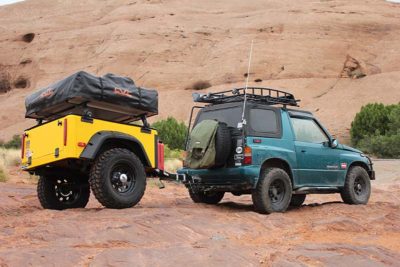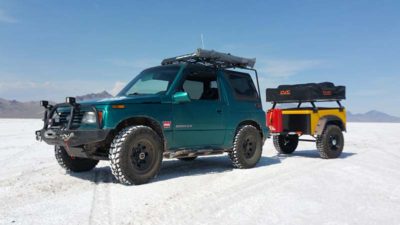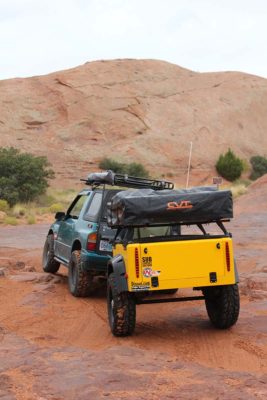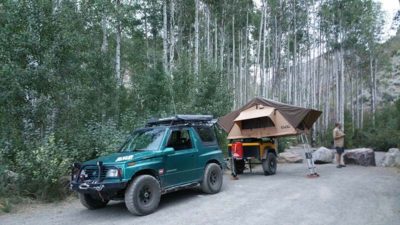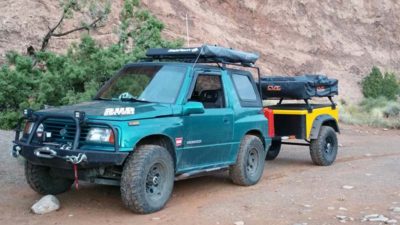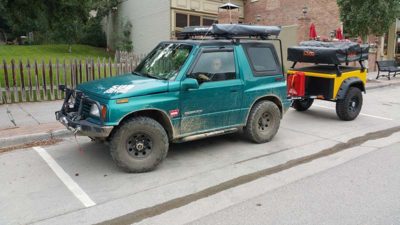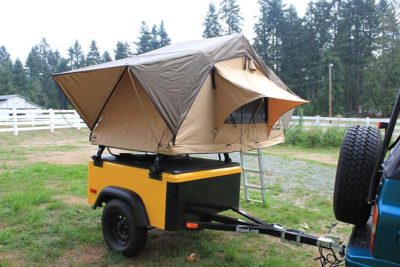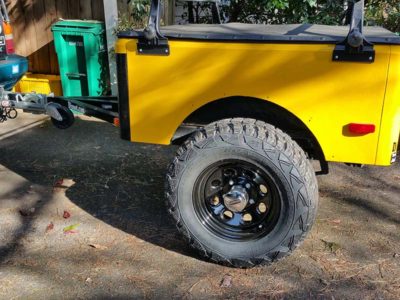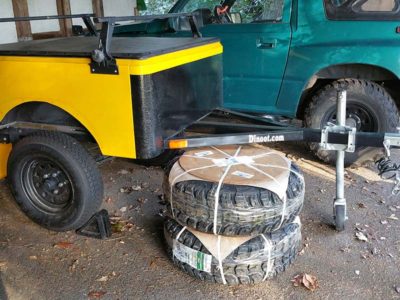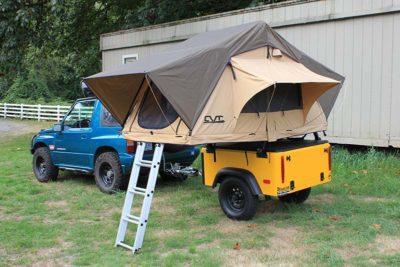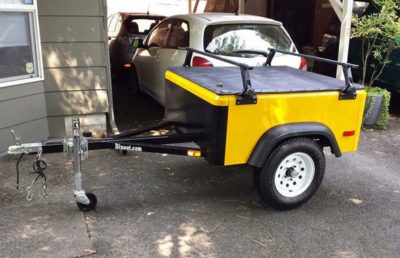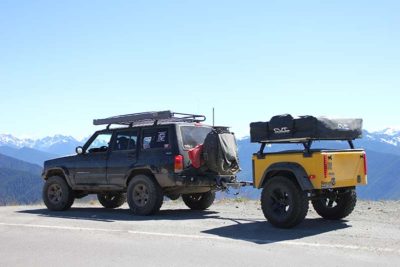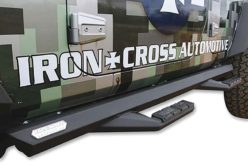Camping Made Easy: Overland Trailer

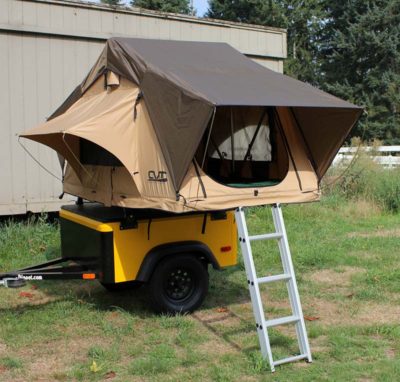
Nearly four years ago, in 2014, my wife and I brought home a wonderful little bundle of joy. It was perfect timing. We’d thought about it for quite some time, talked a lot about what would happen if we did or didn’t, and finally decided we’d go for it. After months of trying, it happened: We bought an off-road trailer.
Rewind a few years to about 2009 or so. While browsing the Internet, I ran across a company called Compact Camping Concepts based in Salem, Oregon. They were offering small, lightweight trailers with storage and rooftop tents, and they could be pulled behind nearly any vehicle. In some photos, Subaru Imprezas and Chevrolet Trackers were pulling these little trailers. I always thought someday I’d love to have one.
Shortly thereafter, Scott Cheney, owner of Compact Camping Concepts, started a second line of trailers called Dinoot. These were kits that could be built on a variety of chassis, including the inexpensive folding trailer variety. The kits were composed of fibreglass sides, a variety of taillight options, and a host of add-on accessories. Not only were these lightweight, they also looked cool. Once again, I thought—I’d love to own one. Scott had a little yellow version he had for promotional use, and it was totally neat. Oh well. Someday.
In 2010 we purchased our first four-wheel drive vehicle. It was a 1995 Suzuki Sidekick with the “big” 1.6-litre engine (the 16V) that produced a whopping 95 hp – at the flywheel – when new in 1995. We called it the Teal Terror, for obvious reasons—it was very teal. Nonetheless, we took the little Suzuki all over the place; it was great. We would take it camping and to off-road rallies. At these rallies, we learned about rooftop tents. We longed for the convenience of an “RTT, but with a two-door convertible Suzuki, an RTT wasn’t exactly in the cards since it was so small and a soft-top.
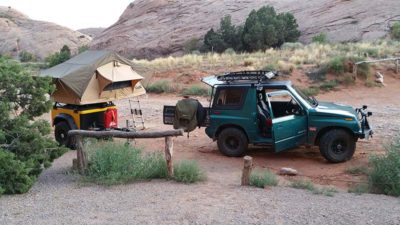
We drove an hour south to Salem and scoped the trailer out. This one was built on a very sturdy welded square-tube chassis. Scott had used it as a demo model, and tried to sell it for a few months, but with its small size and eye-searing yellow paint, it wasn’t selling. However, sometimes you just need to find the right buyer, and we were those buyers. Along with the trailer, Scott sold us a used Thule roof rack that attached using simulated gutter mounts affixed to the sides, and we happily towed it back to Portland. Dinoot still offers the J-Series trailers along with a couple of other models. They’re lightweight and can be pulled behind just about anything, as evidenced by our Suzuki.
We ran our trailer stock for a little while. It had tiny 13-in. trailer tires, small fender flares originally for a Jeep Wrangler, and the Thule crossbars. But we knew it’d get the custom treatment.
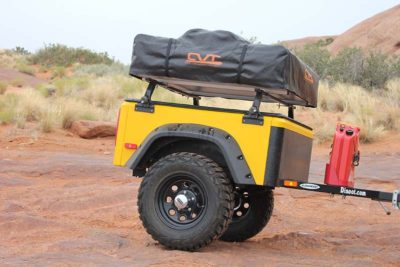
A few months later, we decided to kick things up a notch. We decided we’d lift the trailer and put matching off-road wheels and tires on it. This would also require adding some fender flares.
The lift was super-easy. We simply flopped the axle with a spring-over, which gave us about 6-in. of lift. There were no shocks to worry about, so it took hardly any time. Next, we got a set of wheel adaptors from Nitro Gear & Axle. This would let us go from the axle’s 5×4.5 bolt pattern to the Suzuki’s 5×5.5 pattern. No more need for a dedicated spare—we could just use the Suzuki’s. Plus, it pushed the matching steel wheels out 1.25-in. to clear the leaf springs. We wrapped the wheels in matching 235/75/15 mud terrain tires, too.
Finally, we installed a set of rear Bushwacker Pocket Style fender flares from a Jeep TJ. A little bit of trimming was required, but they fit almost perfectly and provided adequate tire coverage. Et voila! Our trailer had more clearance and more capability. We also added extra fuel via two 5-gallon jerry cans, since the Sidekick’s fuel tank didn’t provide a lot of range.
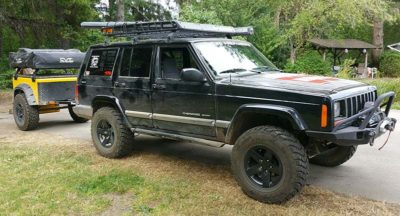
We bid farewell to the Suzuki in December of 2016; it was a bittersweet parting. However, we held onto the trailer, and pull it behind our 2001 Jeep Cherokee. We did change out the wheel adaptors in favor of 1.25-in. spacers (since the Cherokee has the 5×4.5 bolt pattern), and we upsized to a 31×10.50 tire. This just barely clears the inner leaf springs.
However, by the time you read this, we may have also sold the Cherokee in favour of our latest project, a 1992 Mitsubishi Pajero with a diesel engine and 33×10.50 BFGoodrich KM2 tires. We’re not sure yet if the Dinoot can accommodate a 33 without more lift, but we’ll be sure to find out. And even if it doesn’t, we won’t be ditching the Dinoot.
The Dinoots are a great option for those who are looking for a little trailer that doesn’t weigh much, is durable, and won’t break the bank. They can be super simple, or built to the hilt. While we’ve gone through three 4x4s, the Dinoot is a permanent part of the family.
For more information about Dinoot, visit dinoot.com.




